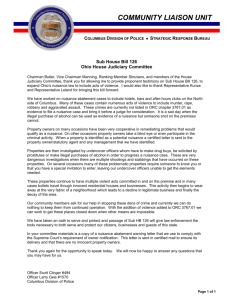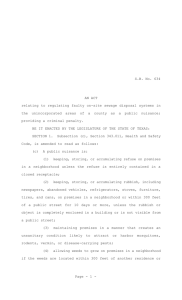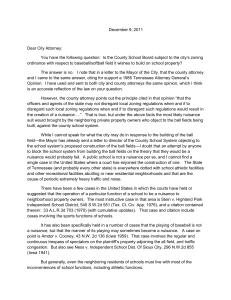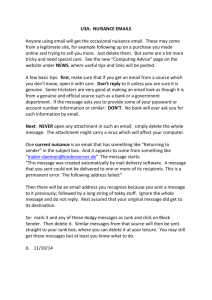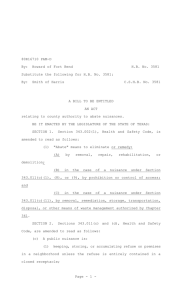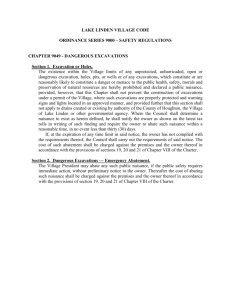PUBLIC NUISANCES Texas Health & Safety Code Chapters 341 and 343
advertisement
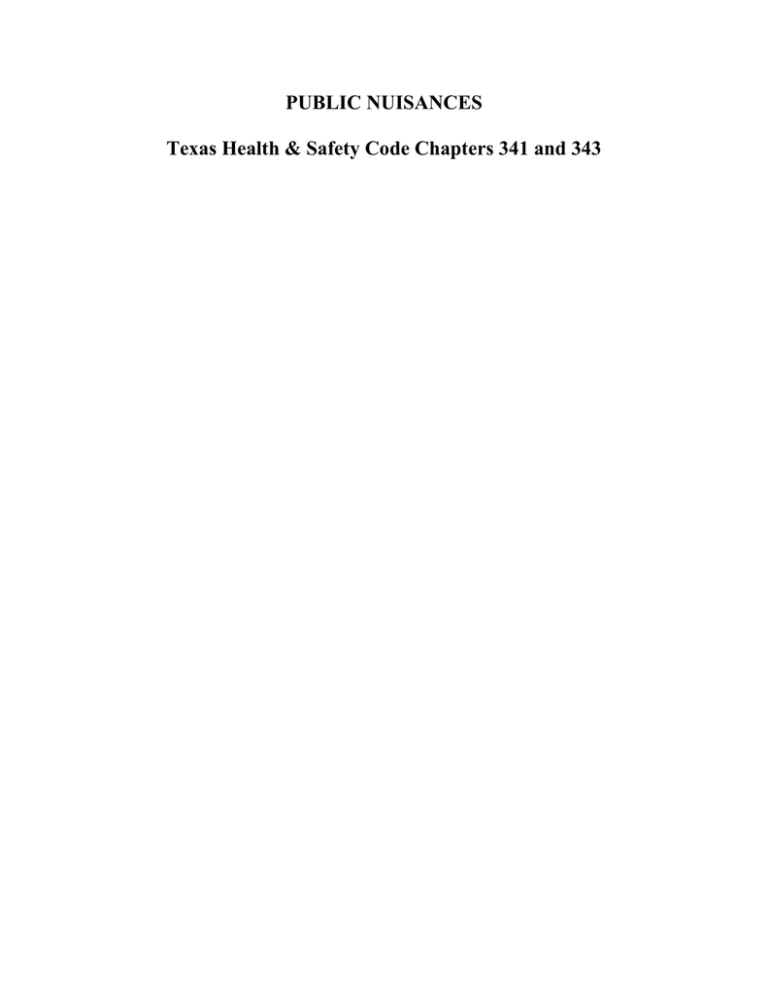
PUBLIC NUISANCES Texas Health & Safety Code Chapters 341 and 343 ELEMENTS TEXAS HEALTH AND SAFETY CODE TITLE 5. SANITATION AND ENVIRONMENTAL QUALITY CHAPTER 341. MINIMUM STANDARDS OF SANITATION AND HEALTH PROTECTION MEASURES SUBCHAPTER A. GENERAL PROVISIONS § 341.001. Definitions In this chapter: … (5) “Person” means an individual, corporation, organization, government, business trust, partnership, association, or any other legal entity. SUBCHAPTER B. NUISANCES AND GENERAL SANITATION § 341.011. Nuisance Each of the following is a public health nuisance: (1) a condition or place that is a breeding place for flies and that is in a populous area; … (5) sewage, human excreta, wastewater, garbage, or other organic wastes deposited, stored, discharged, or exposed in such a way as to be a potential instrument or medium in disease transmission to a person or between persons; (6) a vehicle or container that is used to transport garbage, human excreta, or other organic material and that is defective and allows leakage or spilling of contents; (7) a collection of water in which mosquitoes are breeding in the limits of a municipality or a collection of water that is a breeding area for Culex quinquefasciatus mosquitoes that can transmit diseases regardless of the collection’s location other than a location or property where activities meeting the definition of Section 11.002(12)(A), Water Code, occur; (8) a condition that may be proven to injuriously affect the public health and that may directly or indirectly result from the operations of a bone boiling or fat rendering plant, tallow or soap works, or other similar establishment; (9) a place or condition harboring rats in a populous area; … (11) the maintenance of an open surface privy or an overflowing septic tank so that the contents may be accessible to flies; and (12) an object, place, or condition that is a possible and probable medium of disease transmission to or between humans. § 341.012. Abatement of Nuisance (a) A person shall abate a public health nuisance existing in or on a place the person possesses as soon as the person knows that the nuisance exists. (b) A local health authority who receives information and proof that a public health nuisance exists in the local health authority’s jurisdiction shall issue a written notice ordering the abatement of the nuisance to any person responsible for the nuisance. The local health authority shall at the same time send a copy of the notice to the local municipal, county, or district attorney. (c) The notice must specify the nature of the public health nuisance and designate a reasonable time within which the nuisance must be abated. (d) If the public health nuisance is not abated within the time specified by the notice, the local health authority shall notify the prosecuting attorney who received the copy of the original notice. The prosecuting attorney: (1) shall immediately institute proceedings to abate the public health nuisance; or (2) request the attorney general to institute the proceedings or provide assistance in the prosecution of the proceedings, including participation as an assistant prosecutor when appointed by the prosecuting attorney. § 341.013. Garbage, Refuse, and Other Waste (a) Premises occupied or used as residences or for business or pleasure shall be kept in a sanitary condition. (b) Kitchen waste, laundry waste, or sewage may not be allowed to accumulate in, discharge into, or flow into a public place, gutter, street, or highway. (c) Waste products, offal, polluting material, spent chemicals, liquors, brines, garbage, rubbish, refuse, used tires, or other waste of any kind may not be stored, deposited, or disposed of in a manner that may cause the pollution of the surrounding land, the contamination of groundwater or surface water, or the breeding of insects or rodents. (d) A person using or permitting the use of land as a public dump shall provide for the covering or incineration of all animal or vegetable matter deposited on the land and for the disposition of other waste materials and rubbish to eliminate the possibility that those materials and rubbish might be a breeding place for insects or rodents. (e) A person may not permit vacant or abandoned property owned or controlled by the person to be in a condition that will create a public health nuisance or other condition prejudicial to the public health. SUBCHAPTER F. PENALTIES § 341.091. Criminal Penalty (a) Misdemeanor fine of not less than $10 or more than $200. (b) If prior conviction within a year, a fine of not less than $10 or more than $1,000, confinement in jail for not more than 30 days, or both. (c) Each day of a continuing violation is a separate offense. TEXAS HEALTH AND SAFETY CODE CHAPTER 343. ABATEMENT OF PUBLIC NUISANCES SUBCHAPTER A. GENERAL PROVISIONS § 343.002. Definitions In this chapter: (1) “Abate” means to eliminate by removal, repair, rehabilitation, or demolition. … (3) “Garbage” means decayable waste from a public or private establishment or restaurant. The term includes vegetable, animal, and fish offal and animal and fish carcasses, but does not include sewage, body waste, or an industrial by-product. … (6) “Premises” means all privately owned property, including vacant land or a building designed or used for residential, commercial, business, industrial, or religious purposes. The term includes a yard, ground, walk, driveway, fence, porch, steps, or other structure appurtenant to the property. … (8) “Receptacle” means a container that is composed of durable material and designed to prevent the discharge of its contents and to make its contents inaccessible to animals, vermin, or other pests. (9) “Refuse” means garbage, rubbish, paper, and other decayable and nondecayable waste, including vegetable matter and animal and fish carcasses. (10) “Rubbish” means nondecayable waste from a public or private establishment or residence. (11) “Weeds” means all rank and uncultivated vegetable growth or matter that: (A) has grown to more than 36 inches in height; or (B) may create an unsanitary condition or become a harborage for rodents, vermin or other disease-carrying pests, regardless of the height of the weeds. § 343.003. Effect of Chapter on Other State Law This chapter does not affect a right, remedy, or penalty under other state law. SUBCHAPTER B. PUBLIC NUISANCE PROHIBITED § 343.011. Public Nuisance (a) This section applies only to the unincorporated area of a county. (b) A person may not cause, permit, or allow a public nuisance under this section. (c) A public nuisance is: (1) keeping, storing, or accumulating refuse on premises in a neighborhood unless the refuse is entirely contained in a closed receptacle; (2) keeping, storing, or accumulating rubbish, including newspapers, abandoned vehicles, refrigerators, stoves, furniture, tires, and cans, on premises in a neighborhood or within 300 feet of a public street for 10 days or more, unless the rubbish or object is completely enclosed in a building or is not visible from a public street; (3) maintaining premises in a manner that creates an unsanitary condition likely to attract or harbor mosquitoes, rodents, vermin, or diseasecarrying pests; (4) allowing weeds to grow on premises in a neighborhood if the weeds are located within 300 feet of another residence or commercial establishment; (5) maintaining a building in a manner that is structurally unsafe or constitutes a hazard to safety, health, or public welfare because of inadequate maintenance, unsanitary conditions, dilapidation, obsolescence, disaster, damage, or abandonment or because it constitutes a fire hazard; (6) maintaining on abandoned and unoccupied property neighborhood a swimming pool that is not protected with: in a (A) a fence that is at least four feet high and that has a latched gate that cannot be opened by a child; or (B) a cover over the entire swimming pool that cannot be removed by a child; (7) maintaining a flea market in a manner that constitutes a fire hazard; (8) discarding refuse or creating a hazardous visual obstruction on: (A) county-owned land; or (B) land or easements owned or held by a special district that has the commissioners court of the county as its governing body; or (9) discarding refuse on the smaller of: (A) the area that spans 20 feet on each side of a utility line; or (B) the actual span of the utility easement. (d) This section does not apply to: (1) a site or facility that is; (A) permitted and regulated by a state agency; or (B) licensed or permitted under Chapter 361; or (2) agricultural land. (e) In Subsection (d), “agricultural land” means land that qualifies for tax appraisal under Subchapter C or D, Chapter 23, Tax Code. § 343.012. Criminal Penalty (a) A person commits an offense if: (1) the person violates Section 343.011(b); and (2) the nuisance remains unabated after the 30th day after the date on which the person receives notice from a county official, agent, or employee to abate the nuisance. (b) An offense under this section is a misdemeanor punishable by a fine of not less than $50 or more than $200. (c) If it is shown on the trial of the defendant that the defendant has been previously convicted of an offense under this section, the defendant is punishable by a fine of not less than $200 or more than $1,000, confinement in jail for not more than six months, or both. (d) Each day a violation occurs is a separate offense. (e) The court shall order abatement of the nuisance if the defendant is convicted of an offense under this section. § 343.024. Authority to Enter Premises (a) A county official, agent, or employee charged with the enforcement of health, environmental, safety, or fire laws may enter any premises in the unincorporated area of the county at a reasonable time to inspect, investigate, or abate a nuisance or to enforce this chapter. (b) Before entering the premises, the official, agent, or employee must exhibit proper identification to the occupant, manager, or other appropriate person. § 343.025. Enforcement A court of competent jurisdiction in the county may issue any order necessary to enforce this chapter.

